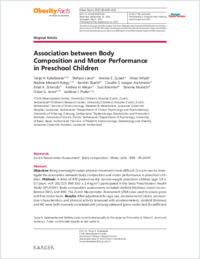Association between Body Composition and Motor Performance in Preschool Children
- Kakebeeke, Tanja H. Child Development Center, University Children's Hospital Zürich
- Lanzi, Stefano Lausanne University Hospital
- Zysset, Annina E. Child Development Center, University Children's Hospital Zürich
- Arhab, Amar Lausanne University Hospital
- Messerli-Bürgy, Nadine Universität Fribourg, Schweiz
- Stuelb, Kerstin Universität Fribourg, Schweiz
- Leeger-Aschmann, Claudia S. Universität Zürich
- Schmutz, Einat A. Universität Zürich
- Meyer, Andrea H. Universität Basel
- Kriemler, Susi Universität Zürich
- Munsch, Simone Universität Fribourg, Schweiz
- Jenni, Oskar G. Child Development Center, University Children's Hospital Zürich
- Puder, Jardena J. Lausanne University Hospital
-
22.09.2017
Published in:
- Obesity Facts. - 2017, vol. 10, p. 420-431
English
Objective Being overweight makes physical movement more difficult. Our aim was to investigate the association between body composition and motor performance in preschool children. Methods A total of 476 predominantly normal-weight preschool children (age 3.9 ± 0.7 years; m/f: 251/225; BMI 16.0 ± 1.4 kg/m2) participated in the Swiss Preschoolers' Health Study (SPLASHY). Body composition assessments included skinfold thickness, waist circumference (WC), and BMI. The Zurich Neuromotor Assessment (ZNA) was used to assess gross and fine motor tasks. Results After adjustment for age, sex, socioeconomic status, sociocultural characteristics, and physical activity (assessed with accelerometers), skinfold thickness and WC were both inversely correlated with jumping sideward (gross motor task β-coefficient −1.92, p = 0.027; and −3.34, p = 0.014, respectively), while BMI was positively correlated with running performance (gross motor task β-coefficient 9.12, p = 0.001). No significant associations were found between body composition measures and fine motor tasks. Conclusion The inverse associations between skinfold thickness or WC and jumping sideward indicates that children with high fat mass may be less proficient in certain gross motor tasks. The positive association between BMI and running suggests that BMI might be an indicator of fat-free (i.e., muscle) mass in predominately normal-weight preschool children.
- Faculty
- Faculté des lettres et des sciences humaines
- Department
- Département de Psychologie
- Language
-
- English
- Classification
- Medicine
- License
-
License undefined
- Identifiers
-
- RERO DOC 323592
- DOI 10.1159/000477406
- Persistent URL
- https://folia.unifr.ch/unifr/documents/307167
Statistics
Document views: 180
File downloads:
- Texte intégral: 173
